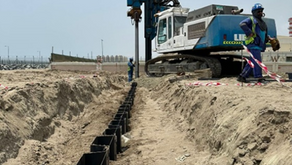Steel Pipes: Choosing Between Seamless and Welded
- Jun 11, 2022
- 3 min read
Welded and seamless steel pipes are the two most common types of steel pipes on the market.

A seamless steel pipe has no seams, as the name indicates and produced via hot rolling and cold rolling.
A welded pipe, on the other hand, is made by rolling of a steel coil to the required gauge thickness, a manufacturing procedure that leaves a seam on the pipe's body. Cutting the seams to the width that corresponds to the size of the pipe to be constructed is the next phase.
Electric Resistance Welded (ERW), Spiral Submerged Arc-Welding Pipe (SSAW), and Longitudinal Submerged Arc-Welding Pipe are three different forms of welded steel pipe (LSAW). These three types of welded steel pipe are manufactured in significantly different ways.
Most of the world’s steel production finds its way into buildings, bridges, and other infrastructure in the form of beams, pipes, and foundation pilings. It makes it possible to build tall because steel can handle the pressures created by the structure’s weight.
In addition to the quality of steel, architects and contractors have to make choices about the kind of steel pipes that serve their project best. For example, bridge foundations have to be able to handle various environmental factors like earthquakes, ship collisions, and strong currents.
In those situations, does it matter if they use seamless or welded pipes? Let’s take a look at the differences to see.
About Seamless Steel Pipes

Seamless pipes are engineered through cold rolling or hot rolling extraction. The process hardens the carbon or alloy steel as it is made to create a strong and light product. They take longer to make and are harder to get dimensions just right.
The advantages of seamless steel pipes are they generally can handle more pressure, which makes them ideal for oil and gas industry applications. There’s no seam exposed to corrosion nor to look unsightly if the pipe is in a visible area. The limits of the production process make it not a great option when you need really big pipes.
About Welded Steel Pipes

Welded pipes start as flat metal plate or strips. These are bent into shape, and the edges are welded together. This means the finished product can be highly precise in terms of diameter and wall thickness.
These are usually used in construction where accurate dimensions are critical and are good for general use since they are usually a more affordable option. Because they can have multiple seams, welded pipes can be made into lots of different shapes and sizes, including extremely big ones for construction.
The downsides are that these pipes usually have thinner walls, which along with the seams make them more vulnerable to pressure. Slight impurities around the seam also leave them exposed to potential corrosion.
Seamless Steel Pipe Vs Welded Steel Pipe

Each pipe has advantages and disadvantages depending on your ultimate use. While seamless has a higher pressure rating, that might not be the highest priority for your project.
The lower cost and larger potential size of a welded pipe might be more important if you’re building a bridge and need a lot of pilings.
Have a Project That Needs Steel Pipes?
Whether you’re constructing a tall building or a wide bridge, steel pipe piles make it possible to get the deep and large foundation you need to handle the load. While seamless versions can handle more pressure, there is a higher cost and less flexibility with them. Welded tends to be better for large construction uses as you can get very accurate dimensions for your project while keeping costs down.
If you have more questions about the steel pipes you need for your construction project, contact our team at whichever global office is closest to you.












